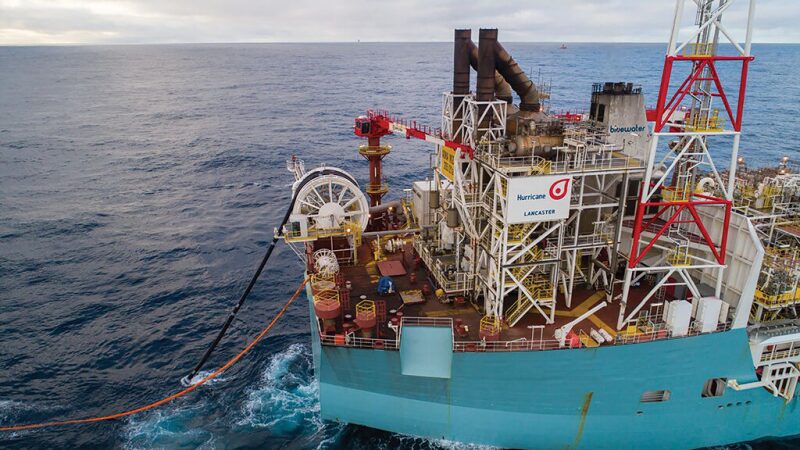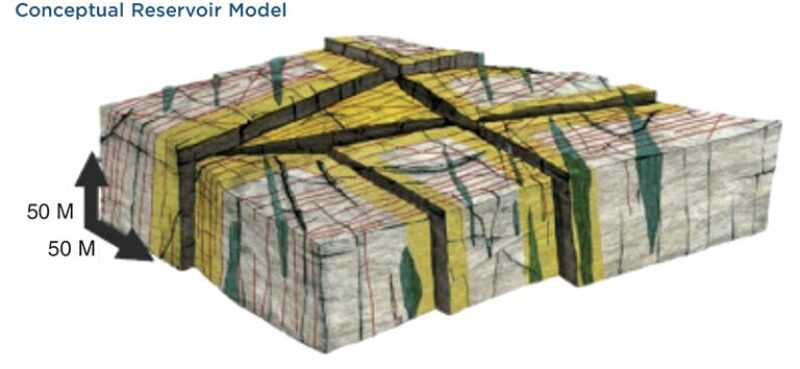A British independent bet its future on proving that fractured basement formations could produce large amounts of oil and gas.
Based on its first two wells, the proposition that these highly fractured layers of awful-quality reservoir rock can produce billions of barrels of oil is looking very unlikely, but there might be something of value down there.
Last April, Hurricane Energy predicted those two development wells could easily produce 17,000 B/D of oil from rock it said held “half a billion barrels of oil.”
Now Hurricane’s ambitious plans and its identity as “basement reservoir specialists” are in tatters.
The initial wells were productive but much of what was coming out of the lower one—205/21a-7z—was water. After 8 months of production the water cut reached 46% from a well that was supposed to be hundreds of meters above the boundary between the oil and water aquifer.
That was not the only evidence suggesting there was something wrong with the plan to develop discoveries in the Lancaster field along Rona Ridge in the West of Shetland area.
On 8 June, Hurricane’s founder and Chief Executive Officer Robert Trice, a geologist with a keen interest in fractured basement rock, resigned, and the company launched a review of the technical work underlying the plan.
Experts were added to the subsurface team, which then made major changes. The most significant change pushed up the depth of the contact point between the oil and water levels by around 300 m, within 1 m below the toe of the lower well.
In other words, three-quarters of the reservoir in the original plan was under water.
The presentation by Beverley Smith, the company’s interim chief executive officer, was a reminder of how a long-term production test can change a reservoir model, even one based on years of work and the drilling of multiple wells.
“Let me start by reminding everyone that we are dealing with a unique and challenging reservoir that was always subject to great uncertainty and where data acquisition has long been problematic,” Smith said.
Lowered Expectations
Hurricane’s remaining Lancaster well (205/21a-6) is producing more than 12,000 B/D, providing critical cash flow for the company, whose future looks altogether different than it did in the days when it predicted its discoveries could potentially produce 2.6 billion bbl of oil, making it the largest undeveloped resource base in the UK Continental Shelf (UKCS).
Based on Hurricane’s technical review, Rystad Energy recently downgraded its production outlook of the UKCS by 300,000 B/D to 1.7 million B/D by the mid-2030s.
“The entire UKCS long-term production forecast has been impacted quite significantly. The main takeaway here is that we may never again see any significant production upsurge in UKCS production,” said Olga Savenkova, an upstream analyst for the data and consulting firm.
It is hard to imagine that a small UK independent whose stock price recently traded at 4 cents a share, down from 40 cents at the start of this year, could alter the outlook for the UK.
But one thing that Trice accomplished as Hurricane’s CEO was to make a convincing case that fractured basement rock could allow the shrinking UK offshore sector to grow again.
It was enough to inspire predictions such as Rystad’s earlier call that basement rock could help push UK offshore output up to 2 million B/D in the future.
There is a lot of oil in offshore basement rock; profitably producing it is the hard part.
The upside is huge—basement rock holds about 20% of the potential production left in the world, according to an SPE technical paper by Petronas and Halliburton, a figure in line with what is thought to be present in the UKCS.
Paper SPE 176332 analyzed a Malaysian offshore prospect and concluded that the volume of oil stored in fractures, plus the thinness of those cracks, would mean the ultimate production at that location would not justify developing it.
Like shale, fractured basement rock production initially flows from the fractures, but the volume is limited. Classic basement rock is ultratight like shale, but unlike shale, it does not have the same carbon-rich composition to make it a source of oil and gas.
Real basement reservoirs, however, are an unpredictable mix, which in Lancaster includes productive conventional rock. There are successful examples of basement rock development around the globe, but as Lancaster showed, it can be hit or miss.
Hurricane’s report cut the potential production from Lancaster by 80%, to about 45 million bbl of oil likely to be produced (best estimate of contingent resources, or 2C, as defined in the SPE Petroleum Resources Management System). It also moved up the oil/water contact level in its Lincoln field by 370 m, which is likely to have a similar impact on potential production.
A spokesperson for the company said it would not go beyond the statement which did not offer estimates of its other fields. Savenkova said the story should be much the same at Hurricane’s nearby Halifax discovery.
All of Hurricane’s currently held discoveries have been made in basement rocks of the Rona Ridge. “Lancaster field and associated discoveries in the southwest Rona Ridge are hosted almost entirely within this fractured basement, so the reservoir properties are cognate [related],” she said.

Rising Tide
The changes in Hurricane’s reservoir model were not small ones.
The potential production has sunk from about 500 million bbl to maybe more than 100 million bbl, if the company can install an effective injection system to maintain the reservoir pressure.
The higher contact level means the reservoir now is mostly less than 100 m thick—far less in some spots and a bit more in others.
Fast-rising water production from the lower well suggested the water was far higher than originally expected by the company, which said the wells were about “430 m above the oil/water contact” in a 2018 presentation.
The rapidly rising water cut in the lower well was an obvious clue—it reached 57% during a few days of production in August, compared to a 15% cut for the upper well located less than 100 m higher.
A surge in water production was a concern, but it did not seem like a big one going into the test. One of the presentation slides noted “an absence of sustained formation water during the first 12 months will remove extreme negative cases from consideration.”
Adding to the evidence was the 120‑psi pressure drop measured over the first year of production. Before the review, slides from Hurricane presentations said a pressure drop of 75 psi was its biggest expected drop in a year. Removing the same volume of fluids and gas from a smaller reservoir will have a larger pressure effect than a space several times larger.
Also, the revised view of the reservoir based on the extended production data analysis was supported by comparable fields in the area, including BP’s Clair field where basement rock is present, though not developed.
The errors were blamed on the methods used to measure and analyze pressure gradients. The changes per meter of depth vary depending on whether water or oil is present.
Smith noted that pressure data are “notoriously difficult to collect in fractured reservoirs and interpretation can be problematic.” She was addressing financial analysts, one of whom bluntly asked if the massive overestimates of reserves were strictly a technical matter.
“To what extent, do you believe that the errors in the previous estimates have only become obvious with the production data you’ve now gathered? Or is it likely the previous management were misrepresenting the size and risk of the project to the board and other stakeholders?” asked James Hosie, director of oil and gas equity research at Barclays.
Smith replied that conventional data used for well planning have their limits, and the production-testing system was installed to provide a long-term production measure “of a hitherto undeveloped reservoir type.
“I think it’s to be expected, therefore, that our understanding of fractured basement would evolve as the production data was accumulated and analyzed,” she said.

Modest Expectations
The mistakes in the original Lancaster evaluation included a few in the company’s favor.
After the technical team downsized the reservoir, the pressure drop still seemed off. The pressure dropped less than would have been likely if the rock was mostly basement rock. The ancient rocks lack the pores and permeability that allow good-quality reservoirs to release more oil and gas as the pressure drops, which limits the declines in the reservoir pressure.
“Preliminary analysis suggests that rather than being primarily a basement reservoir, Lancaster has important oil-bearing sandstones onlapping the basement flanks, which may contain significant volumes of oil,” according to the company’s financial report in September.
That would help explain the strong production from the two wells, both of which ended near the sandstone formation along the upper edges of the basement rock.
Even with all that has gone wrong—Hurricane reported a $308-million loss for the first half of the year because of a charge due to the reduced value of its reserves—its two operations brought in some cash. During that period the wells generated $82 million in revenues despite an average oil price of less than $30/bbl. The $18/bbl cash production cost per barrel allowed it to generate $22 million in free cash flow, according to the report.
Sustaining Lancaster production will require the new management team to raise the money needed to add a water-injection system to sustain that production.
Hurricane likely produced nearly half of the 14.3 million bbl of its reserves (1P and 1C reserves using the SPE system). It estimated that an injection system that sustains the pressure in the field could add from 26 to 90 million barrels of contingent resources.
“We have identified real potential in the onlapping Mesozoic sands, and there is a robust technical case to provide pressure support in the basement reservoir from water injection,” said Antony Maris, the new CEO.
Analysts quoted in stories about Hurricane’s woes question whether it can afford to do the water injection. Savenkova said the company’s lean development approach is up to the task.
“Hurricane’s portfolio remains economically viable, even with much fewer resources involved, due to a phased, risk-averse, and low-cost approach toward field development,” she said.
Its mix of conventional and basement rock production could provide a model for future development, where the basement might add barrels for platforms built to produce from conventional reservoirs.
The Hurricane story points to the need for better methods to accurately evaluate and identify the value in producing from fractured basement rock.
“The game-changer here might be technical-skills development in producing from fractured basement reservoirs, which could potentially increase the recovery factor,” she said. That might create “interest for this type of project going forward.”
For Further Reading
SPE 176332 Revealing the Uncertainty of Heterogeneities in Fractured Basement: A Case Study From the South Malay Basin Offshore Peninsular, Malaysia by G.R. Gaafar, Petronas; E. Najm, Sarvagya Parashar; and I.Z.M. Wu, Halliburton.


